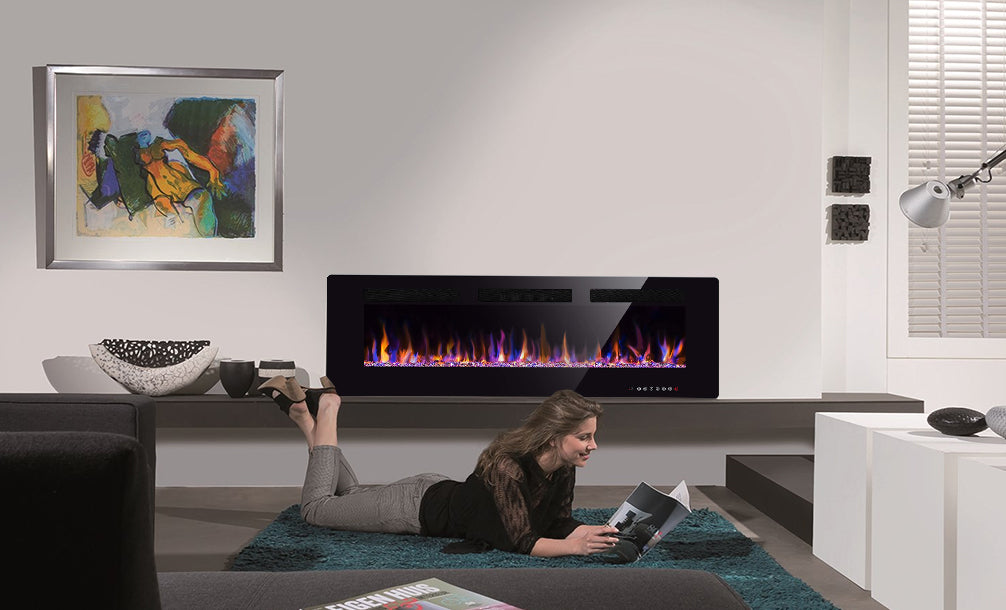Likewise we lucked out and had an outlet that remained in the best area, so we didn't need to do any electrical work. If you are not so fortunate, we recommend discovering a certified electrical expert to get you establish with an outlet inside your framing. Electrical is not a task for a pastime handyman/woman.
GOING SHOPPING LIST:.
Do It Yourself Electric Fireplace How-To Tutorial
The Do It Yourself Electric Fireplace tutorial and expose is here !!! Hooray! However prior to we come down to the meat and potatoes of "How-To" let us initially take a minute to value the where we began. Where we were simply 1 week back and what it appears like today. It's a brief walk down memory lane worth taking, I guarantee.
Now for the develop. The very first, and perhaps crucial action to the develop was picking the best electrical insert for us. This insert would supply us the leaping off point for how to carry out the vision, scale and measurements of our fireplace surround. We picked a RWflame 26 inch square fireplace. Square because, well ... that is the insert shape from my inspo house, and I similar to the classic shape of a square insert. It feels more conventional to me and assists keep the general ambiance in our area from being cold. We chose from there to construct the surround out to 54 inches. The fireplace required 8 inches for depth, we offered it and additional half an inch for some wiggle space. The complete footprint is 54 broad by 8.5 deep, so extremely low profile and attractive as hell. With our strategy in location of 54 inches broad and 8.5 inches deep, flooring to ceiling, we were off to the races. * keep in mind the tutorial listed below is based upon our precise construct *.
1- rwFlame 26 inch electrical insert.
1- Midwood Styles fireplace mantel in rustic walnut.
13- 2 × 4's each 8 feet long (we selected kiln dried to prevent any warping or settling).
2- sheets 1/2 inch sheetrock.
1- box of 2.5 inch basic function wood screws.
1- box of 1 3/8 inch sheetrock nails.
1- box of 8 cent nails.
2- pieces of metal corner beading for the drywall.
1- rise protector.
1- tube of painters caulk.
1- gallon of joint substance.
1- roll of paper joint tape.
1 quart of spackling substance.
1- 4 inch putty knife.
2- quarts paint and guide in 1 (we utilized Ultra Pure White by Behr).
1- big all function sponge.
1- 1 × 8 typical board (for element rack).
2- 180 grit sanding screen.

We did likewise buy a 43 inch Samsung Frame TELEVISION with walnut bezel. That was a quite cent. We did not include this expense in the spending plan since you do not need to get The Frame TELEVISION for your own electrical fireplace construct. Nevertheless, budget plan allowing, we extremely suggest them, they are mind blowing.
We took one 2 × 4 and cut 4- 8 inch lengths off of the 2 × 4. These 8 inch pieces will be the leading and bottom plates of the side walls. Likewise cut 2- 4 3/4 inch lengths from the 2 × 4. These 4 3/4 inch pieces will be for the assistances.
We determined the height of our wall, flooring to ceiling. Then deducted 3 1/4 inches from that ceiling height to identify our stud height. Then took 4 of our complete length 2 × 4's and cut them down to size. For us "to size" is 92 3/4 inch lengths.

Nail the 8 inch pieces of the 2 × 4 (from action 1) to the tops and bottoms of the studs (figured out in action 2), to develop the 2 side walls. Nail 1 of the 4 3/4 inch pieces (from action 1) in between the studs to offer assistance.
Bring the side walls into your house and put them in location. Oftentimes they require a little persuasion from a hammer or rubber mallet to squeeze into location due to the fact that they will have been made to fit comfortably. With these side walls constructed and lined up on the lines you made use of your wall, connect them to the flooring utilizing screws or nails. Our side walls did not line up with a stud on our existing interior wall so we needed to screw the side walls into the ceiling and flooring at a 45 degree angle to capture the leading plate of our existing interior wall. * Prior to proceeding- determine bottom middle and leading to ensure absolutely nothing moved on you throughout set up.
We determined the within range in between the 2 side walls which was 46 inches. Took this measurement and cut a piece of 2 × 4 to size (you need to have scrap left over for this). We connected this 46 inch length of 2 × 4 to the flooring in between the side walls, flush with what will be the front wall of our surround. This 46 inch board is now the bottom plate of our front wall. Repeat this exact same action to set up the front leading plate and after that connected that front leading plate to the ceiling.
Next we figured out how high we desired our fireplace off of the ground. We opted for 12 inches. In order to have this floating result we needed to develop a platform for our fireplace to rest on.
For the platform we cut 3- 9 inch pieces of 2 × 4 for the front of the platform and 3- 10 1/2 inch pieces for the back of the platform (the back of the platform will sit flush to the flooring, the front will rest on the front plate (from action 5) which is why the measurements are various).
Connect the 3- 9 inch pieces along the front plate, 1 on each end versus the stud and one in the middle. Repeat the exact same actions for the back utilizing the 3- 10 1/2 inch pieces * these will connect to flooring.
Next we cut 2- 46 inch pieces of 2 × 4. One that will go in between the front studs (on top of the 9 inch pieces from action 8), and one that will cross the 10 1/2 inch pieces along the back (likewise from action 8). We positioned these 46 inch lengths straight on top of those 9 and 10 1/2 inch boards * there will be a space in the center * Secure 46 inch lengths in location with screws or nails.
Next we put our fireplace on the platform to guarantee it sat level, and we still enjoyed the height. Then we slapped a high 5 and took a break!
With the insert focused we can now round off the framing. We began this next stage by determining up from the platform to the top of the insert 23 1/4 inches. This measurement is not from the platform to the black trim, it is from the platform to the real part of insert that will live inside the wall. This interior part of the insert does get warm so we wished to permit a little space to breath, we provided it a 1/4 inch. This was done by determining from the platform to the top of the insert and including a 1/4 inch to that measurement making is 23 1/2.
We cut 4- 23 1/2 inch pieces of 2 × 4. Set up 2 of these 23 1/2 inch pieces, connect among these 23 1/2 inch lengths to the sexually transmitted disease on the ideal side wall and the other to the stud on the left side wall. The next set of 23 1/2 inch lengths will be set up after action 13.
Cut 1- 46 inch length 2 × 4 connect it to the top of your 23 1/2 inch cut pieces (from action 12).
Now take the 2 staying 23 1/2 inch lengths (from action 12) and position them on either side of the insert, tight however providing simply a little wiggle space. You desire them to be close, however the insert still requires to be flexible. Eliminate the insert and reserved to continue develop.
Determining up from the 46 inch board (from action 13) to the leading plate connected to the ceiling (from action 5). This measurement was 57 inches. We cut 4 pieces of 2 × 4 to size (57 inches).
Connect among these 57 inch lengths to the best side wall stud and among these 57 inch lengths to the left side wall stud. The other 2- 57 inch lengths will be positioned 13 inches apart.
Overall Expense- $499.00.

